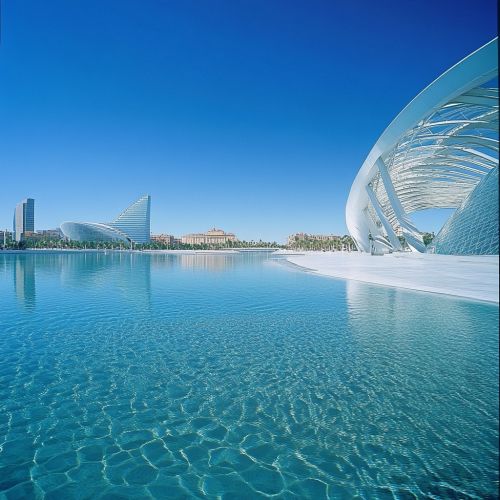City of Arts and Sciences
Overview
The City of Arts and Sciences (Ciudad de las Artes y las Ciencias) is an architectural complex located in Valencia, Spain. It is a cultural and architectural landmark designed by Santiago Calatrava and Félix Candela, along with the engineers who contributed to its construction. The complex is situated at the end of the former riverbed of the Turia River, which was drained and rerouted after a catastrophic flood in 1957. This ambitious project is a prime example of modern architecture and a significant tourist attraction in Valencia.
Architectural Design and Structure
The City of Arts and Sciences is renowned for its futuristic design, characterized by sweeping curves and expansive open spaces. The complex comprises several main structures, each with a unique purpose and architectural style:
L'Hemisfèric
L'Hemisfèric was the first building to open in 1998. Designed to resemble a giant eye, it houses an IMAX cinema, planetarium, and laserium. The building's eye-like shape is accentuated by a surrounding pool of water, which reflects the structure and enhances its visual impact.
Museu de les Ciències Príncipe Felipe
The Museu de les Ciències Príncipe Felipe is an interactive science museum. Its design is reminiscent of a whale's skeleton, with a series of vertical ribs creating a striking visual effect. The museum's exhibits focus on science, technology, and the environment, encouraging visitors to engage with interactive displays.
L'Umbracle
L'Umbracle is a landscaped walk with plant species indigenous to Valencia. It serves as a vantage point for viewing the entire complex. The structure features a series of arches that create a lattice-like canopy, providing shade and a unique aesthetic experience.
L'Oceanogràfic
L'Oceanogràfic is the largest oceanographic aquarium in Europe. Designed by Félix Candela, it features a series of buildings that house different marine habitats, including the Arctic, Mediterranean, and Red Sea. The complex is home to over 500 species of marine life, offering visitors an immersive experience in marine biology.
Palau de les Arts Reina Sofia
The Palau de les Arts Reina Sofia is an opera house and performing arts center. Its design is characterized by a soaring, sculptural form that resembles a ship or a helmet. The building hosts a variety of performances, including opera, ballet, and concerts, contributing to Valencia's cultural scene.
Assut de l'Or Bridge
The Assut de l'Or Bridge is a striking white cable-stayed bridge that connects the northern and southern parts of the complex. Its design features a single pylon that rises 125 meters, making it one of the tallest structures in Valencia. The bridge is an integral part of the complex's transportation infrastructure.
Ágora
The Ágora is a versatile space used for events and exhibitions. Its design is characterized by a large, covered plaza with a distinctive blue exterior. The structure's flexible interior can accommodate a wide range of activities, from sports events to conferences.


Cultural and Scientific Impact
The City of Arts and Sciences serves as a hub for cultural and scientific activities in Valencia. Its diverse range of facilities attracts both local residents and international tourists. The complex plays a crucial role in promoting science education and cultural appreciation through its museums, exhibitions, and performances.
Educational Programs
The complex offers a variety of educational programs aimed at different age groups. These programs are designed to foster an interest in science and the arts, providing hands-on learning experiences that complement traditional education.
Research and Innovation
The City of Arts and Sciences is also involved in research and innovation, particularly in the fields of marine biology and environmental science. L'Oceanogràfic, for example, conducts research on marine ecosystems and conservation efforts, contributing to global scientific knowledge.
Economic and Social Influence
The City of Arts and Sciences has had a significant impact on Valencia's economy and society. As a major tourist attraction, it generates substantial revenue for the city and creates numerous jobs in the tourism and service sectors.
Tourism and Economic Growth
The complex attracts millions of visitors annually, contributing to Valencia's reputation as a cultural and tourist destination. This influx of tourists supports local businesses, including hotels, restaurants, and shops, boosting the city's economy.
Urban Development
The development of the City of Arts and Sciences has spurred urban renewal in the surrounding areas. The transformation of the Turia Riverbed into a green space and the construction of modern infrastructure have revitalized the city, enhancing its appeal to residents and visitors alike.
Criticisms and Controversies
Despite its success, the City of Arts and Sciences has faced criticisms and controversies, particularly regarding its cost and maintenance. The project exceeded its original budget, leading to debates about public spending and financial management.
Budget Overruns
The construction of the complex was significantly more expensive than initially planned, with costs escalating due to design changes and construction challenges. This has led to scrutiny of the project's financial oversight and accountability.
Maintenance Challenges
The complex's avant-garde design, while visually stunning, has posed challenges in terms of maintenance and upkeep. The use of innovative materials and construction techniques has required specialized maintenance, adding to the overall cost of the project.
Conclusion
The City of Arts and Sciences stands as a testament to modern architectural innovation and cultural ambition. Despite the challenges it has faced, the complex continues to be a vital part of Valencia's identity, attracting visitors from around the world and contributing to the city's cultural and economic landscape.
